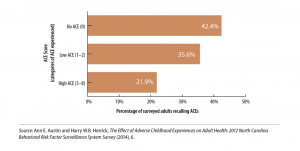Impacts of Safety Nets for Families on Health Outcomes
When we look at moving the needle toward health outcomes, a natural place to address future outcomes is by addressing the need for investment in children’s health.

As we continue to explore our findings from our Health Outcomes qualitative research interviews that we conducted in the summer of 2019, we wanted to highlight the importance of children’s health in moving the needle towards health improvement. When we look at moving the needle toward health outcomes, a natural place to address future outcomes is by addressing the need for investment in children’s health. Poor childhood health leads directly to poor adult health, which eventually contributes to a generational cycle of poor health within families. The 25 experts that we interviewed advised that one of the biggest impacts on childhood health is the ability to support families through health and human services safety nets.

The experts that we interviewed reiterated that the key to improving population-health indicators in the near future AND in the distant future lies in improving our children’s social, economic and physical conditions. Childhood health outcomes will trickle into the adult-health outcomes as generational changes occur. Safety nets, such as nutritional aid, income supports, access to healthcare, and housing assistance, provide parents the opportunity to focus on their child’s well being instead of economic hardship. Without an increase in safety nets, the outcomes can be expected to be exacerbated and the chances of climbing the economic ladder are slim. This then creates a cycle of generational poverty, creating family hardships that we know is impacting children’s health.
“There is a large and growing population of people who have played by the rules, but cannot afford above a poverty-level existence,” said one expert. “This is affecting their kids. They have no health safety net and are often living in multi-generational households.”
Social safety nets must be well developed for families with children. One of the biggest influences on health outcomes for children are ACEs (adverse childhood experiences), which can affect health outcomes well into adulthood. These experiences include physical abuse, sexual abuse, living with a parent who abuses drugs, and similar instances of household dysfunction. According the data, (American Health Rankings, 2019), one out of four children in North Carolina experience ACEs which have been found to be major risk factors for alcoholism, drug abuse, depression, and suicide attempts.8 Experts explained that children experiencing three or more ACEs have a greatly increased risk of health issues. The chart below displays the frequency of ACEs experienced by North Carolinians under the age of 18 by severity of ACE frequency.

Adverse childhood experiences, such as abuse, drug use in the house, and household dysfunction, are likely to occur in households with economic hardship. While the aim is to help people transition out of hardship and climb the economic ladder, in the meantime, health experts suggest that safety nets must be in place. Not only can these safety nets in the form of services increase the chances for economic mobility, but they also have a direct impact on possibly preventing adverse childhood experiences.
“Bottom line: there are fewer opportunities for children in cycles of poverty to grow and realize full potential,” offered one expert.
Sources:
https://www.americashealthrankings.org/explore/health-of-women-and-children/measure/ACEs/state/NC
Ann E. Austin and Harry W.B. Herrick, The Effect of Adverse Childhood Experiences on Adult Health: 2012 North Carolina Behavioral Risk Factor Surveillance System Survey (2014), 6.
